skip to main |
skip to sidebar

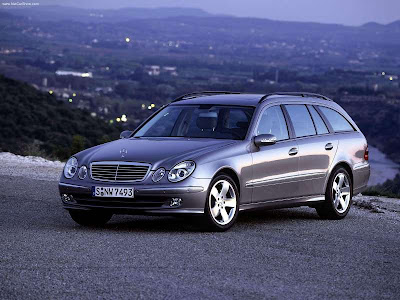







Mercedes-Benz E320 CDI Estate Elegance
Mercedes-Benz E-Class W211
The Mercedes-Benz E-Class is a mid-size luxury car / executive car sold by the Mercedes-Benz branch of DaimlerChrysler. The model line is available with various six and eight-cylinder petroleum gasoline and diesel engines. The E stood for Einspritzung, which is German for fuel injection, which was a very new feature at the time the "E" first appeared in the 1950s. The E-Class is the bestselling Mercedes-Benz model worldwide. It is famous both as luxury or executive transport, and as taxis in countries like Germany and Singapore. In Germany the E-Class is also commonly used as a police interceptor vehicle.
The Mercedes-Benz W211 cars entered production in 2003. They are sold under the E-Class model names. The W211 models replaced the W210 E-Class models.
The W211 E-Class continues the line's push upmarket. The W211-based W219 CLS-Class was new for 2005. In 2002 Mercedes made a facelift for the W210 which begun the launch of the W211.
2006 update
The W211 E-Class was facelifted for 2007, although a new model is less than two years off. Mercedes-Benz called this a "new generation" in their press release, but the changes are mainly superficial and engine-related. The Pre-Safe system was made standard in sedan and wagon models, Neck-Pro safety headrests are added, and Mercedes' blinking brake lights, provisionally approved for use in the United States, are also new. The "Intelligent Light System" is an adaptive headlight system with five different lighting combinations rather than the two found on most cars.
Six of the ten engines available on the W211 were also changed. The four-cylinder Diesel engine in the E200 CDI and E220 CDI was substantially modified for more output. The E320 CDI is updated with Bluetec technology. Mercedes-Benz introduced their Bluetec Diesel system to the E-Class at the 2006 North American International Auto Show as the E320 Bluetec. This system with 'AdBlue' injection uses urea to clean Diesel emissions, the E-Class however only uses an oxidising catalyatic converter and particulate filter combined with nitrogen oxide reducing systems, this alone makes the E320 45-state legal in the United States (The 'Vision GL320 Bluetec' will be 50-state compliant, as it uses 'AdBlue'). Sales begin in autumn 2006 as a 2007 model.
The North American E500 becomes the E550, and the E63 AMG is introduced as well.
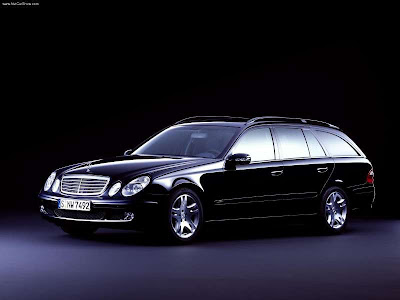

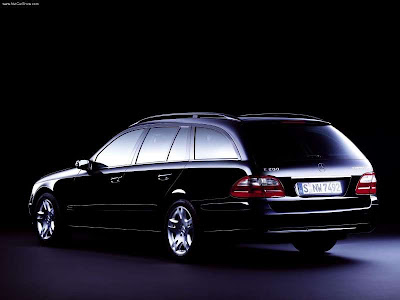






Mercedes-Benz E200 Kompressor Estate Classic
Mercedes-Benz E-Class W211
The Mercedes-Benz E-Class is a mid-size luxury car / executive car sold by the Mercedes-Benz branch of DaimlerChrysler. The model line is available with various six and eight-cylinder petroleum gasoline and diesel engines. The E stood for Einspritzung, which is German for fuel injection, which was a very new feature at the time the "E" first appeared in the 1950s. The E-Class is the bestselling Mercedes-Benz model worldwide. It is famous both as luxury or executive transport, and as taxis in countries like Germany and Singapore. In Germany the E-Class is also commonly used as a police interceptor vehicle.
The Mercedes-Benz W211 cars entered production in 2003. They are sold under the E-Class model names. The W211 models replaced the W210 E-Class models.
The W211 E-Class continues the line's push upmarket. The W211-based W219 CLS-Class was new for 2005. In 2002 Mercedes made a facelift for the W210 which begun the launch of the W211.
2006 update
The W211 E-Class was facelifted for 2007, although a new model is less than two years off. Mercedes-Benz called this a "new generation" in their press release, but the changes are mainly superficial and engine-related. The Pre-Safe system was made standard in sedan and wagon models, Neck-Pro safety headrests are added, and Mercedes' blinking brake lights, provisionally approved for use in the United States, are also new. The "Intelligent Light System" is an adaptive headlight system with five different lighting combinations rather than the two found on most cars.
Six of the ten engines available on the W211 were also changed. The four-cylinder Diesel engine in the E200 CDI and E220 CDI was substantially modified for more output. The E320 CDI is updated with Bluetec technology. Mercedes-Benz introduced their Bluetec Diesel system to the E-Class at the 2006 North American International Auto Show as the E320 Bluetec. This system with 'AdBlue' injection uses urea to clean Diesel emissions, the E-Class however only uses an oxidising catalyatic converter and particulate filter combined with nitrogen oxide reducing systems, this alone makes the E320 45-state legal in the United States (The 'Vision GL320 Bluetec' will be 50-state compliant, as it uses 'AdBlue'). Sales begin in autumn 2006 as a 2007 model.
The North American E500 becomes the E550, and the E63 AMG is introduced as well.
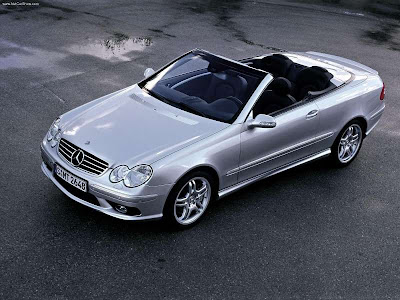



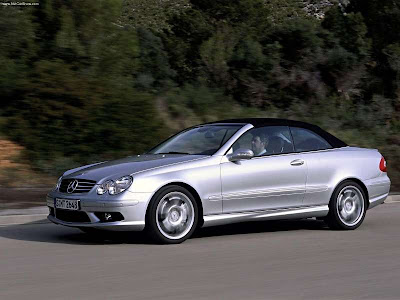



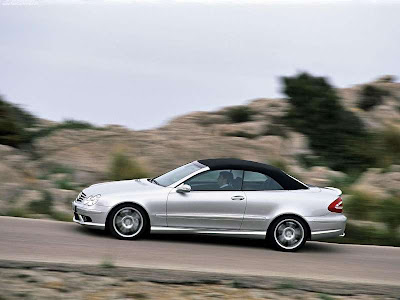
Mercedes-Benz CLK55 Cabriolet AMG
Mercedes-Benz CLK-Class W209
The Mercedes-Benz W209 cars have been produced since 2002. They are sold under the CLK-Class model names. The W209 is based on the W203 C-Class. It replaced the C208 CLK-Class after 2004 which were the first car to carry the CLK moniker.
The W209 is available in two body styles, a coupe and a cabriolet, and with three engines available, a V6 (CLK320 in ’04, CLK350 thereafter), V8 (CLK500), and supercharged V8 (CLK55). The cabriolet (Designated with an A, as in CLK500A) features a fully automatic retractable soft top covered by a metal tonneau that can be raised and lowered from outside the vehicle using the key fob.
Market position and competitors
The CLK is designed to fill the mid-luxury market position for coupes and convertibles. It is Mercedes-Benz’s only 4-seat cabriolet. Its direct competitors in the cabriolet market are the Volvo C70 and the Lexus SC430, although it is available with larger engines than any of its direct competitors. The CLK is positioned midway between the BMW 3 series coupe/cabriolet and the 6 series coupe/cabriolet.
Characteristics
The CLK is a superlative vehicle whose handling is exceptionally precise even under extreme cornering, road, and weather conditions, and whose performance is equal to the fastest readily available sports cars on the market. Performance is electronically limited to 135mph in the CLK350 and CLK500 models, and to 155mph in the CLK55 model. The electronic limitation is felt as a point at which the car simply won’t go faster, not as an artificial fuel cutoff that can cause bucking as in some vehicles.
The Electronic Stability Control (ESP) and Antilock breaking system (ABS) are both excellent aids to handling, making such feats as a 90’ degree turn on a typical two lane intersection from 50mph possible using simple hard breaking and turning with no significant fishtailing. Although the ESP system can be manually turned off, it never actually allows the wheels to spin completely freely. For example, the ESP system makes drifting (intentional high-power fishtailing) impossible without shutting the ESP system off using a factory test protocol that end-users cannot enable.
Both the 5-speed (’04 and ’05) and 7-speed automatic transmissions are so smooth that shifting is noticeable only unusual driving conditions. The cars have a manual sport/comfort mode switch that sets the transmission to start in 2nd gear and shift earlier in comfort mode. The new 7-speed transmission ads about 20% better fuel mileage in real driving conditions over the 5-speed with no loss in performance, although the additional shifting can be noticeable. In the CLK500, at 80mph, the 5-speed transmission runs at about 3000rpm, while the 7-speed runs at about 2200rpm. Both transmissions include automatic best gear finding so that the driver need not keep track of which gear the car is in during performance driving, and in the AMG model, the transmission can be set to stay in the highest possible gear for the best possible performance.
The 5-speed CLK500 gets an average of 15mpg in real city driving conditions, whereas the 7-speed CLK500 get an average of about 18mpg under the same conditions. Both add about 3mpg for highway driving.
The new 3.5 liter engine delivers enough performance to make the car seem basically the same along the line of motors; The earlier 320 felt like a nimble car but was not in the same class as the CLK500/55 in terms of performance. The CLK55 AMG ads considerably less additional performance than the AMG versions of other Mercedes-Benz cars, which probably accounts for its relative rarity.
Comfort and convenience
Mercedes-Benz concentrates its ergonomic design engineering efforts on subtle luxuries, such as seat-belt presenters, automatically lowering headrests when the seat is moved back so that it’s in the correct position for tall drivers, and lowering the passenger side mirror to show the curb when the car is in reverse.
More obvious conveniences include automatically dimming mirrors, in-dash navigation instructions, steering wheel control of audio system, iPod, and integrated telephone system, and cornering fog lamps that illuminate the road when you turn in the same direction as the turn indicators signal.
Model changes
The W209 was introduced in 2002. At introduction, it was available with a 3.2 liter engine, a 5.0 liter engine, and a 5.5 liter engine. The 2004 CLK was the last Mercedes Benz automobile to use the venerable D2B (Digital Data Bus) optical fiber media system introduced a decade earlier. The most obvious problem with this system was the clearly obsolete CD-ROM based navigation system.
The 2005 update included a new 3.5 liter 6 cylinder and the MOST (Media Oriented Serial Transport) media system used in the rest of the Mercedes Benz line, bringing along a significantly upgrade DVD based navigation system and iPod integration as optional features. The 2006 included an improved 3.5 liter 6 cylinder engine and added the steering wheel shift paddles from the AMG model to the CLK500.




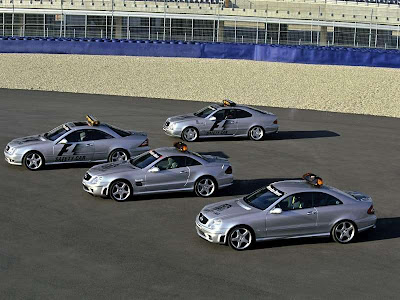



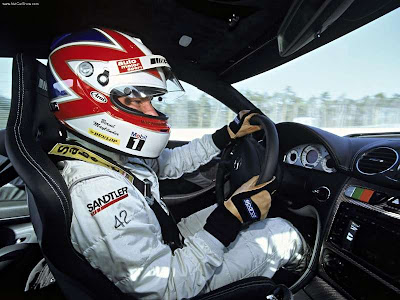
Mercedes-Benz CLK55 AMG F1 Safety Car
Mercedes-Benz CLK-Class W209
The Mercedes-Benz W209 cars have been produced since 2002. They are sold under the CLK-Class model names. The W209 is based on the W203 C-Class. It replaced the C208 CLK-Class after 2004 which were the first car to carry the CLK moniker.
The W209 is available in two body styles, a coupe and a cabriolet, and with three engines available, a V6 (CLK320 in ’04, CLK350 thereafter), V8 (CLK500), and supercharged V8 (CLK55). The cabriolet (Designated with an A, as in CLK500A) features a fully automatic retractable soft top covered by a metal tonneau that can be raised and lowered from outside the vehicle using the key fob.
Market position and competitors
The CLK is designed to fill the mid-luxury market position for coupes and convertibles. It is Mercedes-Benz’s only 4-seat cabriolet. Its direct competitors in the cabriolet market are the Volvo C70 and the Lexus SC430, although it is available with larger engines than any of its direct competitors. The CLK is positioned midway between the BMW 3 series coupe/cabriolet and the 6 series coupe/cabriolet.
Characteristics
The CLK is a superlative vehicle whose handling is exceptionally precise even under extreme cornering, road, and weather conditions, and whose performance is equal to the fastest readily available sports cars on the market. Performance is electronically limited to 135mph in the CLK350 and CLK500 models, and to 155mph in the CLK55 model. The electronic limitation is felt as a point at which the car simply won’t go faster, not as an artificial fuel cutoff that can cause bucking as in some vehicles.
The Electronic Stability Control (ESP) and Antilock breaking system (ABS) are both excellent aids to handling, making such feats as a 90’ degree turn on a typical two lane intersection from 50mph possible using simple hard breaking and turning with no significant fishtailing. Although the ESP system can be manually turned off, it never actually allows the wheels to spin completely freely. For example, the ESP system makes drifting (intentional high-power fishtailing) impossible without shutting the ESP system off using a factory test protocol that end-users cannot enable.
Both the 5-speed (’04 and ’05) and 7-speed automatic transmissions are so smooth that shifting is noticeable only unusual driving conditions. The cars have a manual sport/comfort mode switch that sets the transmission to start in 2nd gear and shift earlier in comfort mode. The new 7-speed transmission ads about 20% better fuel mileage in real driving conditions over the 5-speed with no loss in performance, although the additional shifting can be noticeable. In the CLK500, at 80mph, the 5-speed transmission runs at about 3000rpm, while the 7-speed runs at about 2200rpm. Both transmissions include automatic best gear finding so that the driver need not keep track of which gear the car is in during performance driving, and in the AMG model, the transmission can be set to stay in the highest possible gear for the best possible performance.
The 5-speed CLK500 gets an average of 15mpg in real city driving conditions, whereas the 7-speed CLK500 get an average of about 18mpg under the same conditions. Both add about 3mpg for highway driving.
The new 3.5 liter engine delivers enough performance to make the car seem basically the same along the line of motors; The earlier 320 felt like a nimble car but was not in the same class as the CLK500/55 in terms of performance. The CLK55 AMG ads considerably less additional performance than the AMG versions of other Mercedes-Benz cars, which probably accounts for its relative rarity.
Comfort and convenience
Mercedes-Benz concentrates its ergonomic design engineering efforts on subtle luxuries, such as seat-belt presenters, automatically lowering headrests when the seat is moved back so that it’s in the correct position for tall drivers, and lowering the passenger side mirror to show the curb when the car is in reverse.
More obvious conveniences include automatically dimming mirrors, in-dash navigation instructions, steering wheel control of audio system, iPod, and integrated telephone system, and cornering fog lamps that illuminate the road when you turn in the same direction as the turn indicators signal.
Model changes
The W209 was introduced in 2002. At introduction, it was available with a 3.2 liter engine, a 5.0 liter engine, and a 5.5 liter engine. The 2004 CLK was the last Mercedes Benz automobile to use the venerable D2B (Digital Data Bus) optical fiber media system introduced a decade earlier. The most obvious problem with this system was the clearly obsolete CD-ROM based navigation system.
The 2005 update included a new 3.5 liter 6 cylinder and the MOST (Media Oriented Serial Transport) media system used in the rest of the Mercedes Benz line, bringing along a significantly upgrade DVD based navigation system and iPod integration as optional features. The 2006 included an improved 3.5 liter 6 cylinder engine and added the steering wheel shift paddles from the AMG model to the CLK500.








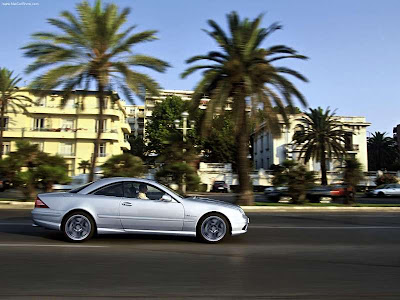
Mercedes-Benz CL600
Mercedes-Benz CL-Class W215
The third generation of the CL is the W215-chassis coupé of 2000 to 2006. It is based on the 2000-2004/5 Mercedes-Benz S-Class, thogh it rides on an 8-inch shorter wheelbase. It is offered as four models: the V8-powered CL500, the supercharged V8-powered CL55 AMG, the V12-powered CL600 and the rare bi-turbo V12-powered CL65 AMG. The limited-edition V12-powered CL63 AMG was sold in 2001 only. All models seat four.
The CL coupes come equipped with the very latest in Mercedes-Benz technology, and the CL is always the first model to receive new technological features (it introduced the revolutionary Active Body Control fully-active suspension system and Bi-Xenon HID lights, both as world firsts).The CL-class has among the most popular luxury coupes in the world, outselling rivals such as the Jaguar XK8 coupe and the Bentley Continental GT.
The CL-class has a lengthy list of available features. The following features come standard: climate control, all-leather interior, wood trim, trip computer, CD, navigation system, front heated and cooled seats, power moonroof. Optional features include a heated steering wheel and voice-activated telephone.
Exclusive “designo” packages are also available. These packages add custom color metallic paint, custom color Nappa leather interior and exotic burl walnut trim. They are available in three variants: designo Cashmere, designo Espresso and designo Silver.
As with all major German manufacturers (except Porsche) Mercedes limit their cars to 250 km/h (155 mph). The justification for having two models with the same power (CL600 and CL55 AMG) is that the CL55 AMG is sportier and more responsive, while the CL600 is more luxurious with a smoother ride. The CL65 AMG is made to order in very small numbers, and is the most powerful CL to date.
The CL63 AMG is the rarest CL of all. It was produced only in November 2001, and just 26 examples were ever built for sale. The V12-powered CL63 AMG was only sold in Europe and Asia. Mercedes-Benz never offered the CL63 for sale; all were sold exclusively through AMG with a base price of £110,000 (~US$200,000).
From 1999 through 2002, the V12-equipped cars feature a cylinder deactivation system called Active Cylinder Control. The feature was dropped when the 493hp biturbo V-12 was introduced. Engine Power Torque 0–100 km/h (62 mph) Top speed
CL500 5.0 L V8 225 kW (306 hp DIN) 460 N·m (339 ft·lbf) 6.3 seconds 250 km/h (155 mph)
CL600 Turbocharged 5.5 L V12 368 kW (500 hp DIN) 800 N·m (590 ft·lbf) 4.8 seconds 250 km/h (155 mph)
CL55 AMG Supercharged 5.5 L V8 368 kW (500 hp DIN) 700 N·m (516 ft·lbf) 4.8 seconds 250 km/h (155 mph)
CL63 AMG Naturally aspirated 6.3 L V12 326 kW (444 hp DIN) 620 N·m (457 ft·lbf) 5.5 seconds 250 km/h (155 mph)
CL65 AMG Twin-Turbocharged 6.0 L V12 450 kW (612 hp DIN) 1000 N·m (737.6 ft·lbf) 4.4 seconds 250 km/h (155 mph)




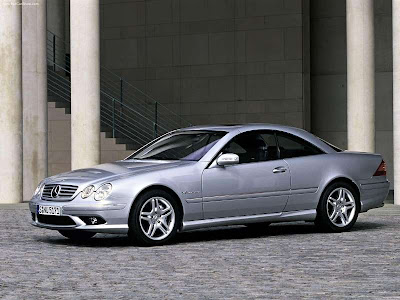



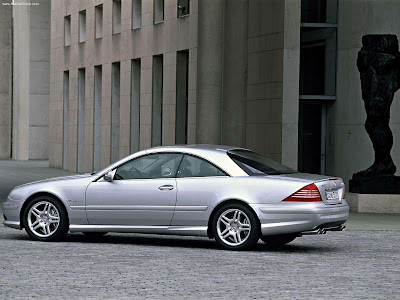
Mercedes-Benz CL55 AMG
Mercedes-Benz CL-Class W215
The third generation of the CL is the W215-chassis coupé of 2000 to 2006. It is based on the 2000-2004/5 Mercedes-Benz S-Class, thogh it rides on an 8-inch shorter wheelbase. It is offered as four models: the V8-powered CL500, the supercharged V8-powered CL55 AMG, the V12-powered CL600 and the rare bi-turbo V12-powered CL65 AMG. The limited-edition V12-powered CL63 AMG was sold in 2001 only. All models seat four.
The CL coupes come equipped with the very latest in Mercedes-Benz technology, and the CL is always the first model to receive new technological features (it introduced the revolutionary Active Body Control fully-active suspension system and Bi-Xenon HID lights, both as world firsts).The CL-class has among the most popular luxury coupes in the world, outselling rivals such as the Jaguar XK8 coupe and the Bentley Continental GT.
The CL-class has a lengthy list of available features. The following features come standard: climate control, all-leather interior, wood trim, trip computer, CD, navigation system, front heated and cooled seats, power moonroof. Optional features include a heated steering wheel and voice-activated telephone.
Exclusive “designo” packages are also available. These packages add custom color metallic paint, custom color Nappa leather interior and exotic burl walnut trim. They are available in three variants: designo Cashmere, designo Espresso and designo Silver.
As with all major German manufacturers (except Porsche) Mercedes limit their cars to 250 km/h (155 mph). The justification for having two models with the same power (CL600 and CL55 AMG) is that the CL55 AMG is sportier and more responsive, while the CL600 is more luxurious with a smoother ride. The CL65 AMG is made to order in very small numbers, and is the most powerful CL to date.
The CL63 AMG is the rarest CL of all. It was produced only in November 2001, and just 26 examples were ever built for sale. The V12-powered CL63 AMG was only sold in Europe and Asia. Mercedes-Benz never offered the CL63 for sale; all were sold exclusively through AMG with a base price of £110,000 (~US$200,000).
From 1999 through 2002, the V12-equipped cars feature a cylinder deactivation system called Active Cylinder Control. The feature was dropped when the 493hp biturbo V-12 was introduced. Engine Power Torque 0–100 km/h (62 mph) Top speed
CL500 5.0 L V8 225 kW (306 hp DIN) 460 N·m (339 ft·lbf) 6.3 seconds 250 km/h (155 mph)
CL600 Turbocharged 5.5 L V12 368 kW (500 hp DIN) 800 N·m (590 ft·lbf) 4.8 seconds 250 km/h (155 mph)
CL55 AMG Supercharged 5.5 L V8 368 kW (500 hp DIN) 700 N·m (516 ft·lbf) 4.8 seconds 250 km/h (155 mph)
CL63 AMG Naturally aspirated 6.3 L V12 326 kW (444 hp DIN) 620 N·m (457 ft·lbf) 5.5 seconds 250 km/h (155 mph)
CL65 AMG Twin-Turbocharged 6.0 L V12 450 kW (612 hp DIN) 1000 N·m (737.6 ft·lbf) 4.4 seconds 250 km/h (155 mph)





















































